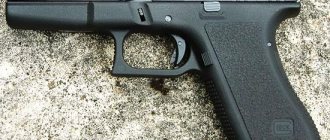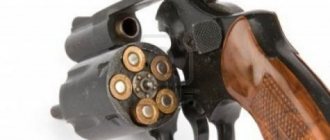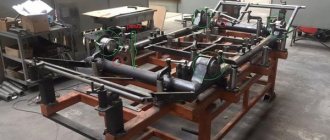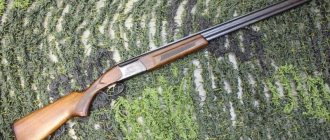Since ancient times, an ax in human hands has been used both as a working tool and as a melee and sometimes long-range weapon. Depending on the tasks and goals, the production of a forged antique ax, the method of sharpening, the length of the ax, as well as the shape and weight differed.
As the factory industry developed, forged samples began to give way to stamped ones. The latter were produced in large quantities, were inexpensive and were suitable in cases of rare use of the weapon. For permanent use, products made by private craftsmen and specialized firms were increasingly valued.
Handmade axes are high-quality forged products made for specific tasks. Such tools are designed for frequent use and convenience, and are characterized by increased strength and reliability.
Features of a forged ax
Forged products are distinguished by high-quality metal work.
The key feature of a hand-made forged ax is attention to high-quality metal work. Using ancient techniques, a blacksmith processes it over the entire shape, hardens the structure and eliminates defects in the metal, ensuring its strengthening.
Flow-oriented industrial manufacturing uses one of two manufacturing methods—casting or stamping. Both help to quickly obtain the desired products in a given quantity. At the same time, no attention is paid to the quality of the metal itself - its residual stress, internal cracks, uneven crystal structure and other defects.
These disadvantages are compensated by a thicker shape, which increases the weight of the instrument. Such stamped products are not always convenient for regular use, especially in traveling conditions.
In this case, the subtlety of terminology should be taken into account. Many stamped axes are called forged because of the specifics of metalworking. According to it, this manufacturing method is called “forging in dies”, which is why in stores the products are passed off as forged.
Main stages
The procedure consists of three main stages, which are performed sequentially without interruption:
- Annealing.
- Hardening.
- Vacation.
Let's look at them in order.
Annealing
The annealing process is necessary to change the structure of the metal, cleanse the structural memory of the steel and relieve stress incurred during casting or previous processing.
Figure 2 – Heat treatment modes for steel U7, U7A
The procedure consists of performing two steps:
- Heating to a temperature of 740-760°.
- Smooth cooling up to 550° at a speed of 30-50° per hour.
Considering the temperature difference, we can conclude that the cooling process will take from 4 to 7 hours.
The main difficulty is temperature control.
Steel heated to 768° has a red-burgundy color with a dim glow.
Without experience, it is difficult to understand whether the metal has reached the desired temperature or not. An ordinary magnet will come to the rescue. At a temperature of 768°, it ceases to be attracted to the surface of the steel, which makes it possible to determine the temperature with sufficient accuracy. After reaching the desired degree of heating, the furnace is turned off, and the ax is left in it for gradual cooling. Usually the process lasts slightly longer than the calculated value - about 10 hours.
Hardening
To harden, the metal must be heated again to a temperature of 800-830°. First, the surface is cleaned of scale, for which you need to use a hard wire circle. Heating is carried out until the metal acquires a bright red tint.
Important! When heating to 800°, you will have to use your own understanding of the situation, since there are no more correct ways to determine the temperature at home. It is a good idea to look at a sample of the metal that has been heated for hardening beforehand to get an idea of what it should look like.
After heating, the metal must be cooled. Use water at a temperature of 30° and oil. The working part of the ax is immersed in water (3-4 cm), actively moving to prevent the formation of a vapor layer. The duration of immersion in water is 3-4 seconds, after which the entire ax is immersed in oil. At the same time, you need to make sure that it does not catch fire.
Vacation
Tempering is the final part of the entire process, designed to relieve metal stress and reduce its brittleness. Before starting the tempering, it is necessary to clean the surface of the ax again with a wire wheel, since it will be necessary to carry out visual inspection of the surface. It should acquire a blue tarnish color corresponding to the correct degree of heating.
The procedure is carried out in a conventional oven heated to 300°. The ax is placed in the oven and kept for 1 hour, after which it is removed and cooled naturally in the open air. Test processing with a file can be a criterion for the quality of hardening.
Attention! The higher the tempering temperature, the softer the metal will become.
Forging Technique Instructions
There are several options for forging an ax:
- forge welding, in which the product is obtained by combining two types of metals - often ST3 for the base of the ax and tool steel for the blade;
- solid forged samples obtained from one piece of appropriate steel;
- connecting the blade with rivets.
The latter option currently has no practical application and is used only for decorative items. The greatest preference is given to solid forged products, in which the eye is punched with a chisel rather than bent and welded.
A solid forged tool implies the use of high-quality carbon or alloy steel. First, it is made according to a given shape, then it undergoes processing to compact the metal, and then it is polished.
Hardening with self-tempering
Another method of hardening a tool is self-tempering. First, the tool is heated in a furnace to the hardening temperature. Then, the cutting part is cooled to a temperature of 150-170 degrees. After this, the cutting part is cleaned of scale in order to see the tarnish colors. Let's see how the purple color goes. The tool is kept in air until the heat from the hot part heats the cooled part to a temperature of 250-300 degrees. We judge this by the color of the tarnish. Everything is purple. Cool. Water is used as a quenching medium. Only to cool the cutting part it is heated to 30 degrees. And for the final cooling of the ax it is heated to 50 degrees.
Design
The curved shape of the short handle prevents the tool from slipping out of your hands.
Any ax consists of two key aspects - the head and the handle. The first is divided into:
- blade, which is often hardened separately;
- striker, also called blade;
- eye (eye) - hole for an ax;
- butt - the reverse side, which in certain cases can be used to drive nails.
The design of both the handle and the nozzle will differ depending on the purpose of the product. The following ax options are available:
- carpentry - a lightweight tool, sharpened at 20 degrees;
- carpenter's ax - a massive example for working with logs;
- cleaver - a tool with a narrow blade and a long handle, designed for chopping wood;
- hunting - a universal lightweight product aimed at long stays in the forest; tourist samples are also distinguished;
- butcher for cutting meat.
Battle axes are also noted separately, but currently they are purchased only as collectible weapons with the appropriate documents. At the same time, many guns intended for everyday use replicate the design of combat guns and are sold openly.
Lever
The ax handle differs in length and shape depending on the purpose of the tool. Joinery and carpentry products have a short ax with a curved shape and a fungus at the end, which prevents it from slipping out of your hands. The profile shape of the handle should resemble an egg - this option gives a better grip and does not put strain on your hands.
The cleavers have a long straight handle designed for a wide swing. If you miss, the blade will go into the ground rather than hit your leg. The handle is selected in a similar manner for work in the taiga. If you have a lot of wood chopping to do, a long handle will do. For small branches and working at an angle, a short ax handle is better.
Nozzle
Fixation with five wedges
The attachment to the handle is made with the expectation of reliable fixation of the ax. If it is not strong enough, it may slip during the swing. If the cutting is done in the taiga, it will be difficult to find a lost tool. Also, an insecurely secured tool poses a danger both to the person chopping and to people nearby.
Fitting the handle is a simple process, but requires attention to detail. The weapon must sit completely on the ax handle, after which it is fixed with metal or wooden wedges. They are pre-lubricated with glue or resin, which is also used to fill them.
Despite the reliability of such an attachment, you should constantly check the tightness of the ax and the presence of wedges. If they work for a long time, they can fly out, which creates a risk of losing the tool itself.
There is a method of reverse attachment, especially suitable for cleavers with a long straight handle. The principle of operation is to significantly thicken the handle at the point of fixation. The ax itself is put on from the bottom and pushed into place.
The thickening at the end prevents slipping and does not require wedges. In this case, it is important that the thickened part of the handle protrudes over the ax by at least 5 cm. In this case, during operation, it will only fit more tightly onto it.
The most common weapon of the Slavs
Starting from the 9th century, the battle ax was in service with the princely squad along with a sword and broadsword. The heavily armed infantry of the Slavs greatly valued this type of weapon for its reliability and impact power; a skilled warrior could easily break a shield with it and break chain mail rings.
In oral folk art, heroes are often described with huge axes in their hands, although in fact the weight of military weapons did not exceed 500 grams, and only very strong warriors could afford weapons of greater weight.
Of course, the weight and size of a weapon during hostilities impresses the enemy. The panic generated by the sight of a strong warrior with a deadly weapon in his hands helps to defeat the enemy and get the desired prey.
Since the Slavs bought tools and weapons both in Europe and in Asia, they could also find elegant small hatchets - coins brought from the East and a Scandinavian ax and even a brodex, a two-handed ax with enormous destructive power.
Operating rules
A cleaver with a reverse attachment to the handle.
The technique of use depends on its purpose. Short-handled tools are designed for short swings. Cleavers and axes for chopping - on the contrary, for wide movements.
The cutting itself is ensured by the weight and sharpness of the tool. The chopping person applies force only during the initial swing; then the inertia of movement is taken into account. At this stage, you only need to monitor the accuracy of the hit.
The option in which chopping is achieved with the application of chopping force is not considered correct. In certain situations it is necessary, but in most cases it leads to fatigue in a short time with minimal results.
Proper chopping technique is designed for precise strikes without the application of additional effort. One diagonal swipe cuts off the sliver, the second horizontally chops it off. When chopping, due to inertia, the chopper can work for a long time without getting tired.
When working with an ax, safety precautions should also be taken into account. In addition to checking the serviceability of the tool, take into account the direction of the blow - it should come from the chopping person. If you have insufficient experience, it is important to take into account the probability of a miss, as well as the fact that a branch, especially a small one, will be cut down immediately, after which the ax will continue to move.
It is also important to consider the position of the legs. The stand must be stable; if the ax slides further, the chopper should not “go away” after it. When chopping wood, the legs are spread wide apart, which is especially important with a short handle. In this case, the tool will not enter the leg by inertia.
The process of making an ax looks like this:
Material selection
The following grades of wood are used for the handle:
- oak;
- birch;
- maple and some others.
In order for this part to be of high quality, the wood must be harvested before frost. After the workpieces are ready, they need to be dried. They should lie in a ventilated area for about a year. But, some craftsmen claim that the drying period should be about 5 years. In fairness, it must be said that in an emergency, you can use an undried workpiece, but this is a temporary option, the handle will quickly wear out.
Cutting out the template
To obtain an ax of the required size, you must use a template made from cardboard. As a sample, to obtain it, you can use the tool that is convenient to work with. That is, you need to put it on a sheet of thick cardboard and outline it with a pencil.
Ax template
By the way, the size of the ax can be determined based on the height and physique of the person who will work with it.
Making a blank
A block is hewn out from a block that has been dried. Work must be carried out along the fibers. The size of the bar should be 100 mm larger than the size of the finished product. The size of the part where it will be installed, and the blade itself should be 2 - 3 mm larger than the size of the eye.
The template prepared in advance must be laid on the surface of the block. At the same time, leave allowances for processing. From the front its size is 10 mm, in the tail it is 90 mm. This allowance is necessary so that the handle does not crack when pulled onto the ax itself. Upon completion of work, this allowance is removed.
Hewing out an ax
To bring the part to the required dimensions, two cuts must be made in the upper and lower parts of the workpiece, but their depth should not reach the contour of 2 mm. Excess material can be removed using a chisel. After this, using a file with a large notch, the corners, transitions and other surfaces of the handle are leveled. Abrasive sandpaper is used to finish the surface.
Making an ax
Impregnation with waterproof compound
To increase the resistance of the handle to moisture, special compounds are used. But it is permissible to use drying oil or linseed oil. The handle is covered with this liquid until it stops being absorbed into it.
The handle of the tool should not slip in the hand and therefore, it is not recommended to cover it with any paints or use any pads.
By the way, it wouldn’t hurt to add a coloring pigment, for example, orange, to the waterproof coating. Then the tool with a bright handle will not disappear on the site.
Soviet and Swedish army forged axes
Over the past decades, the most popular forged axes have been Swedish and Soviet products. The former are highly reliable and are produced by several companies for the needs of the army.
The Swedish ax is used in construction, automobile and sapper troops. Despite the different production, the army model has a clear standard - 70 cm handle length, ax head - 18 cm, blade width - 10 cm.
Soviet forged axes produced between 1950 and 1970 are also famous for their quality. The optimal choice is considered to be products manufactured in the USSR before 1960. They were also produced for the needs of the army and remained in storage in military warehouses. Gradually they are sold out, get to resellers and through them - to ordinary buyers.
The Soviet ax is the only way to buy a high-quality forged product at the price of a stamped one. They are often sold with an old handle and this makes them unattractive in appearance. However, if you find such a product and replace the ax handle, you can get an excellent tool.
Exclusive hand forged axes
The work of craftsmen is often accompanied by decorative embellishments, combining quality with originality.
Handmade axes are produced by many craftsmen and small firms. Such products are distinguished by the quality of metal processing, which ensures a long service life of the tool. The disadvantage of such samples is their high price.
When choosing a forged ax, you should not buy the first one you come across in the nearest store. No matter how much it costs and no matter how much the seller boasts, it will most likely be stamped forging. The exception is company stores and well-known brands that value their reputation.
When choosing a hand-forged ax, it is important to consider its purpose. Often exclusive samples, even for everyday work, are decorated with decorative elements. However, more often such products have a simple, practical design designed for specific tasks.
Secrets of hardening a heat source
There are several options for devices that can bring the heating of a steel part to the desired temperature threshold. The ideal option is an industrial or home-made muffle furnace.
In the absence of such a tool, you can use another home assistant - a blowtorch.
A fairly powerful jet of flame makes it easy to heat parts of small thickness to the required temperature. Remember to move the torch along the plate being hardened to achieve even heating.
In addition, it is possible to use ordinary charcoal together with a blowtorch. To do this, dig a small hole in the soil, pour coal into it, and place the hardened blades of the knives on the edge. Heat the coal together with the plates with a lamp until the latter reaches the required heating. This method prevents the rapid cooling of the unheated part of the workpiece and its overheating.
The third option is to make a small forge. It can be either coal or gas. The main structural elements of the device are the housing and the source of forced air. The base of the coal hearth can be made of a steel sheet 10 mm thick with a piece of pipe with a diameter of about 20 cm welded at the bottom and an outlet from it for connecting a hose from the outlet of a household vacuum cleaner.
Do not forget to drill several holes in the sheet of sufficient diameter to supply air. Wood (barbecue) or coal is used as fuel.
Sources
- https://SevenTools.ru/metally/kak-pravilno-zakalit-topor.html
- https://setafi.com/instrumenty/topor/kak-zakalit-topor-v-domashnih-usloviyah/
- https://smm-star.com/kak-pravilno-zakalit-topor/
- https://VashNozh.ru/topory/zakalka-topora
- https://kovkapro.com/kovka-tehnologiya/zakalka-topora/
- https://printeka.ru/prochee/kak-zakalit-topor-v-domashnih-usloviyah.html
- https://2lzz.ru/stolyarnyj-instrument/kak-zakalit-topor
- https://teplobloknn.ru/metally/zakalka-topora.html
The world's best brands of forged axes
The choice of tool should take into account its purpose.
You can purchase a high-quality forged ax from one of the following companies:
- Gransfors Bruks is a Swedish company that has been producing axes since 1902, all products are forged by hand, and the craftsmen put their personal mark on especially good work;
- Hultafors is a Swedish company founded in 1883, has a wide range of products, distinguished by the quality of products, including processing, hardening and attachment;
- Hults Bruk is one of the oldest Swedish manufacturers, founded in 1697, axes are forged from Solid Swedish steel, and handles are made from hickory wood;
- Wetterlings produces heavy and versatile axes from recycled scrap metal, the quality of the workmanship is high;
- Djarv Hantverk AB is a family company that produces exclusive designs at high prices, targeting professional carpenters, restorers and woodcarvers;
- Husqvarna - good quality, often found in Russian stores, has two branches of production from standard axes with a wooden handle and products made from reinforced polyamide;
- Fiskars is a well-known company producing forged stamping, which is distinguished by ambiguous quality. Tourist hatchets, for which there is a wide selection of sizes, are considered optimal; products from this company are not recommended for heavy, constant work.
In addition to these brands, the quality of private craftsmen should also be taken into account. Many of them also produce exclusive, high-quality products that rival well-known brands.
Hardening an ax at home - video, photos, nuances
How to qualitatively harden an ax at home? The relevance of this issue is explained by the wide demand for this tool. In addition, using the example of such a simple household tool as an ax, one can examine in detail the nuances of several types of heat treatment - annealing, hardening and tempering.
A good forged ax can cut a nail
It is quite easy to find out that a new ax purchased from hand or at a hardware store needs to be hardened: if the blade of the tool is very soft (which can be determined by its wrinkles even when cutting knots of small thickness), then it needs high-quality hardening. If cracks appear on the working part of the ax during operation or the blade becomes chipped, it should be fully tempered.
Advantages and disadvantages
Taking into account manufacturing and processing technology, forged axes have both advantages and certain disadvantages. The advantages of such products include:
- high quality, superior to stamped samples;
- the handle is often made of valuable wood, the ax itself is perfectly mounted;
- the shape and sharpening are designed for a specific type of work.
Among the disadvantages of a forged ax are:
- the cost of the product increases proportionately with its quality;
- the narrow specialization of sharpening does not allow the ax to be used for any work;
- sharpening requires not only knowledge of its specifics, but also certain tools;
- the choice is limited, it is not always possible to find a high-quality product in the store, and ordering from a specialist will cost more.
In this context, the purchase of a tool must take into account its practical application. If the tool is supposed to be rarely used for different purposes, there is no point in paying extra money for quality; it is enough to purchase an ordinary universal axe.
If we are talking about professional use or reliability in hunting, then it’s worth investing in an exclusive or branded product. It will be expensive, but in a couple of years it will pay off its investment.
How to properly harden a blade at home?
Hardening is a complex process, the result of which depends on the experience and knowledge of the master doing it. When hardening an ax, only the blade is subjected to the most severe treatment, and the butt and eye (hole for the ax) are left in their original state. This is important, since hardening increases not only the hardness, but also the fragility of the metal, and continuous processing can make the tool unsuitable for work - any blow can split it. Therefore, the hardening mode must be chosen so that the result is a hard strip of metal near the working edge and a softer, more viscous rest of the tool.
The essence of the process is the restructuring of the crystalline and atomic lattice of the metal, which occurs under the influence of high temperatures and a sharp change in the degree of heating. You will need a standard muffle furnace, which should be purchased or rented.











